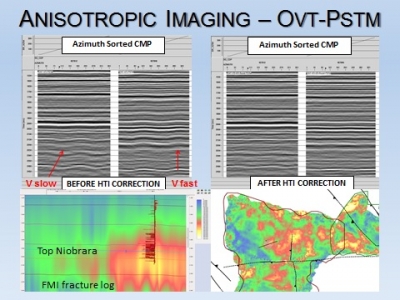Correcting and measuring anisotropy (VTI, HTI) in 3D wide-azimuth seismic data can provide valuable information to drilling engineers regarding in-situ stress fields, natural fracture systems, and geomechanical rock properties. Calibrating anisotropy attributes with reservoir properties can improve the completion process and hydraulic fracture simulation.
HTI
Proper assessment of HTI (azimuthal) anisotropy should be performed before pre-stack migration (PSTM) to determine whether an azimuth preserving migration is necessary. It is also important during pre-processing to avoid multi-trace filter techniques when attempting to attenuating pre-stack noise (ground-roll, etc.). Harsh filter techniques can dampen HTI anisotropy making it difficult to accurately measure in subsequent analysis. Carefully examining wide azimuth 3D data by offset (CMP offset sort) and azimuth (CMP azimuth sort) can help determine the presence of HTI in the 3D dataset.
If HTI exists, an offset vector tile (OVT) pre-stack time migration (PSTM) is recommended to preserve azimuth. After OVT-PSTM azimuthal velocity analysis can be performed to produce an azimuthally varying NMO field. From the azimuthal NMO several attributes (vfast, vslow, azimuth vfast, vfast-vslow) can be obtained to assess stress and fractures. Mathematical components of these velocity attributes can produce “direct fracture indicators” within the reservoir. Also, these attributes can be co-rendered and mapped on a horizon basis to streamline interpretation. In addition, they can be integrated with additional attributes (curvature, etc.) and physical data (wells, production, cores, FMI logs, etc.).
Azimuth Sorted CMP


